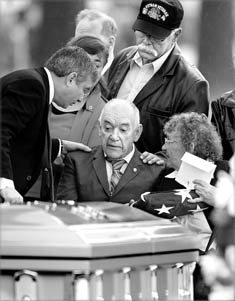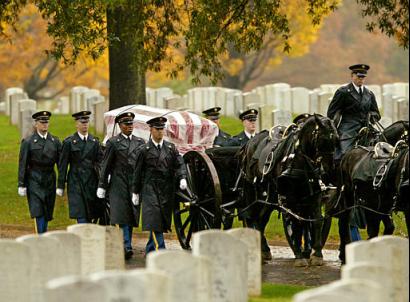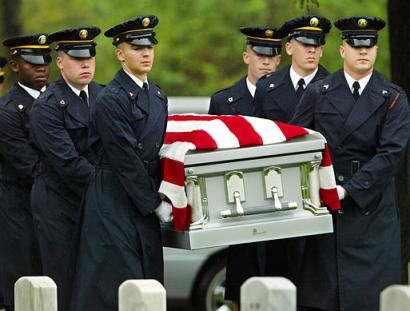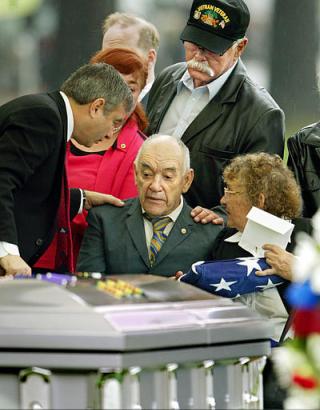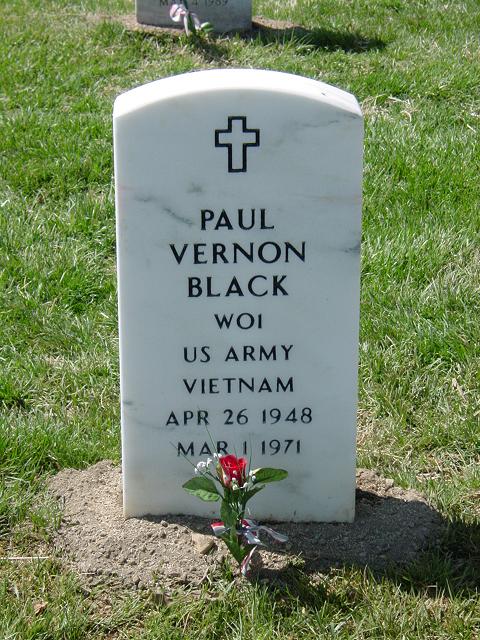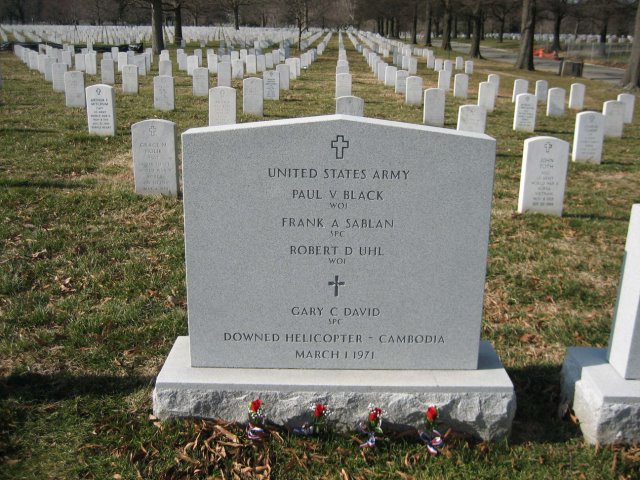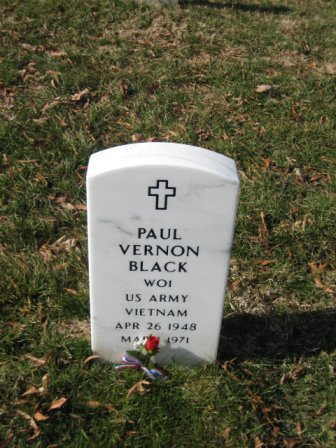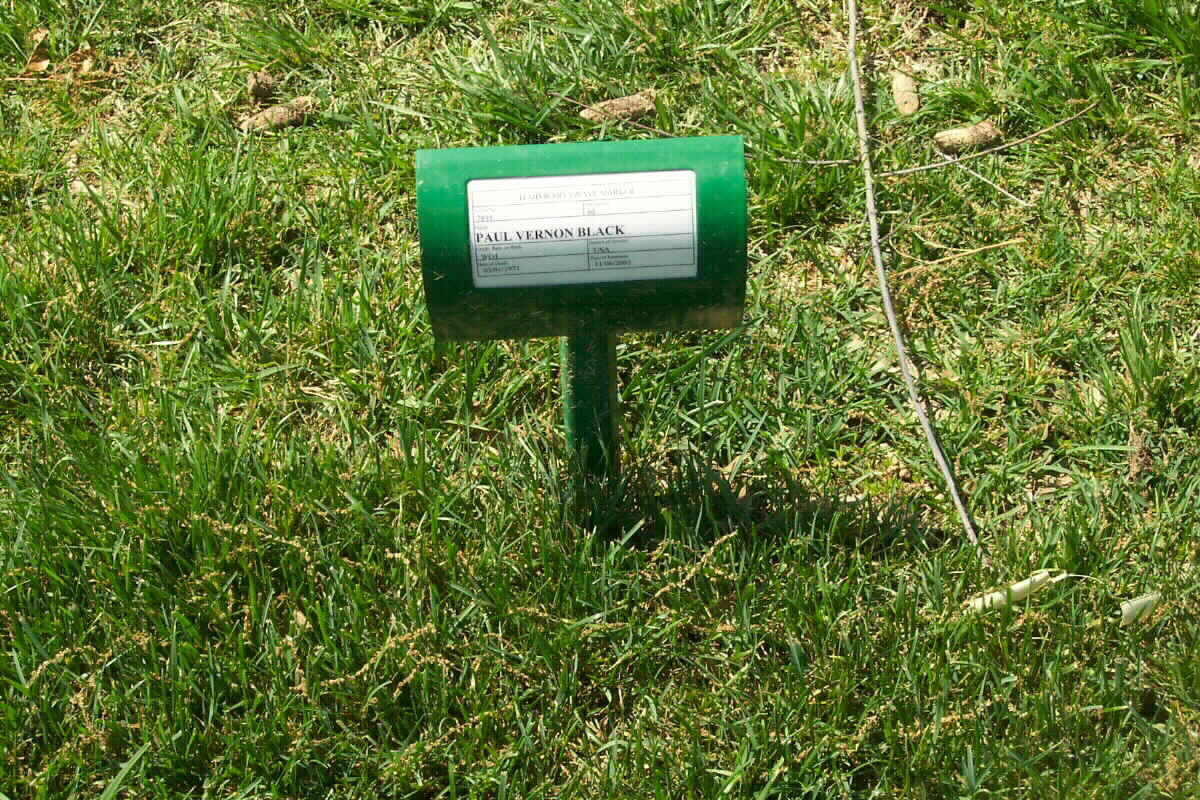Full Name: PAUL VERNON BLACK
Wall Name: PAUL V BLACK
Date of Birth: 4/26/1948
Date of Casualty: 3/1/1971
Home of Record: CENTRAL VALLEY, CALIFORNIA
Branch of Service: ARMY
Rank: WO
Casualty Country: CAMBODIA
Thirty-two years after his helicopter was shot down over Cambodia,
Paul Black’s remains were buried at Arlington National Cemetery Thursday.
Black’s father Paul, above center, is comforted at the service for his son by friends and relatives.
After 32 years, couple finally can say farewell to son
Half a world and 32 years distant from where their son’s helicopter went down, Jim and Jane Black of Port Orford finally said farewell Thursday at Arlington National Cemetery.
Paul Vernon Black and three others were on an aerial reconnaissance mission over Cambodia when the chopper was shot down March 1, 1971.
Only the remains of the other three men were recovered and identified at the time. Not until this year was the Army able to confirm that fragments recovered in 1995 from the site belonged to Black, who was 22.
For his parents the past 32 years have brought disbelief, anguish and frustration at not knowing if their son had died in the crash or was taken prisoner.
“He’d been POW-MIA for 32 years with no trace of anything,” Jane Black said.
A dozen family members from four generations joined about 50 other mourners at a service for the four.
In a drizzle, an honor guard marched to their gravesite, saluting one casket for the group and another for Black alone.
After the ceremony, Darryl Black and Jolene Gruener remembered Paul as the smart, fun-loving brother who liked to tinker with cars and drive fast, but who signed up for officer training even as opposition to the war spread.
“He wasn’t afraid to take on a challenge, right up to the end,” Darryl Black said.
A cousin, Don Garner, didn’t like being in the service but regarded it as the price of freedom. Paul, however, was serving his second tour in Vietnam, duty he volunteered for.
Garner recalled when Black flew in in his helicopter for a visit while both were in Vietnam. They talked about family and old times.
“I asked him why he re-enlisted, and he said he just felt that he wanted to be a warrant officer, and he wanted to do more for the country,” Garner recalled. “Paul accepted the whole philosophy of what he was doing and 100 percent believed in it.”
At the funeral service, Chaplain Douglas Fenton told mourners he hoped that Arlington cemetery, established to bury the nation’s Civil War dead, would serve as “a place of profound peace” after their many years of uncertainty.
“I hope for you it can be as close to the Promised Land as we can provide on earth,” he said.
For Jim and Jane Black, both in their 80s, it was close enough.
“Let’s let this be the end,” Jane Black said.Finally, a farewell at Arlington
11/07/03
Don Garner still smiles when he remembers how Paul Black, his cousin and fellow soldier, swooped in by helicopter one day in June 1970 for an eight-hour visit in Vietnam that gave both a precious respite from the war.
“It was like God — and I’m not a religious person — had sent him to me just to cheer me up a little bit, and he did.” Garner said Thursday. “It was a warm, inner feeling that I was going to be OK, I was going to go home.
“When I heard he was missing, it just gutted me.”
Three decades and half a world away, Garner joined Black’s parents, who traveled from Oregon to Arlington National Cemetery near Washington, to bury Paul Vernon Black and three comrades amid full military honors and to say farewell at last.
Black, Warrant Officer Robert Uhl of San Mateo, Califoria, Specialist Gary David of Pottstown, Pennsylvania, and Specialist Frank Sablan of Phenix City, Alabama, were on an aerial reconnaissance mission when their helicopter was shot down over Cambodia on March 1, 1971.
Only the remains of the other three men were recovered and identified at the time. Not until this year was the Army able to confirm that fragments recovered in 1995 from the site belonged to Black.
For parents Jim and Jane Black of Port Orford, the past 32 years have brought periods of disbelief, then anguish and frustration at not knowing for sure that Paul had died in the crash and had not suffered in a prison camp.
“He’d been POW-MIA for 32 years with no trace of anything,” Jane Black said.
A dozen family members from four generations joined about 50 other mourners at a service for the four who died aboard the downed helicopter. Then they braved a relentless drizzle as an honor guard marched to their gravesite, saluting one casket for the group and another for Black alone.
After the ceremony, Darryl Black and Jolene Gruener remembered Paul as the smart, fun-loving brother who liked to tinker with cars and drive fast, but also as the dutiful high school student who signed up for officer training even as opposition to the war spread.
“He wasn’t afraid to take on a challenge, right up to the end,” Darryl Black said.
Gruener recalled Paul’s love of adventure throughout their childhood in Redding, Calif., and his curiosity about the world around him. Although Paul died at 22, she said, he lived a life fuller than most.
“That’s what I got from Paul: question, question, experience, probe, explore,” Gruener said. “I identified with Paul. My kids, they know all the Paul stories.”
Garner, now 54, said he always felt a brotherly connection to his cousin as they grew up. That bond was sealed forever during their last visit Paul arranged as the two fought in Vietnam.
In those precious last hours, the two shared a meal, played chess and recalled road trips to see their grandmother in Yreka, California. They also revealed their views and fears about their role in a war that was increasingly unpopular at home.
Garner, who wears a ponytail and earring, didn’t like being in the service but regarded it as the price of freedom. Paul, however, was serving his second tour in Vietnam, duty he volunteered for.
“I asked him why he re-enlisted, and he said he just felt that he wanted to be a warrant officer, and he wanted to do more for the country,” Garner recalled. “Paul accepted the whole philosophy of what he was doing and 100 percent believed in it.”
Over the years, Garner said he harbored doubts about the war, but “today proved to me that it was worth it — the war in Vietnam, the whole thing.”
At the funeral service, Chaplain Douglas Fenton told mourners he hoped that Arlington cemetery, established to bury the nation’s Civil War dead, would serve as “a place of profound peace” after their many years of uncertainty.
“I hope for you it can be as close to the Promised Land as we can provide on earth,” he said.
For Jim and Jane Black, both in their 80s, it was close enough.
“Let’s let this be the end,” Jane Black said.
Troops’ Remains From Vietnam Era Buried
Thursday Nov 6, 2003
More than three decades after Army Warrant Officer Paul Black’s helicopter was shot down by the Viet Cong, his remains were buried with those of three wartime comrades Thursday at Arlington National Cemetery.
About 50 mourners gathered under a drizzling rain with their hands over their hearts as a horse-drawn caisson carried the flag-draped casket. It contained the recently identified remains of Black, along with those from three other men who were on the Huey helicopter with him when it crashed and burned in Cambodia on March, 1, 1971.
Black, Warrant Officer Robert Uhl of San Mateo, California, Specialist Gary David from Pottstown, Pennsylvania, and Specialist Frank Sablan of Phenix City, Alabama, were on an aerial reconnaissance mission at the time. Black, 22, was from Central Valley, California.
Black’s remains were recovered by the military’s Joint POW/MIA Accounting Command in 1995, and then identified in early January, according to Gina Jackson with the Hawaii-based command.
His comrades’ remains were recovered and identified in 1971, she said.
Thirty-two years after their U.S. Army helicopter was shot down over Cambodia,
the remains of four soldiers are carried by a horse-drawn caisson to their burial site
during a military funeral at Arlington National Cemetery, Thursday, November 6, 2003.
Warrant Officer 1st Class Paul Vernon Black, Sergeant First Class Gary Charles David,
Specialist Frank Sablan, and Warrant Officer 1st Class Robert D. Uhl died while
flying a combat mission near Kampong Cham, Cambodia, March 1, 1971.
Their remains were identified through DNA analysis
Thirty-two years after Warrant Officer Paul Black’s U.S. Army helicopter was shot down
over Cambodia, his remains are carried by a casket team during a military funeral at
Arlington National Cemetery November 6, 2003.
Paul Black’s remains, found with others in his helicopter, were
identified through DNA analysis earlier this year.
Thirty-two years after Warrant Officer Paul Black’s U.S. Army helicopter
was shot down over Cambodia, his father, Jim Black of Port Orford, Oregon,
center, is comforted at a military funeral for his son at Arlington National Cemetery
Thursday, November 6, 2003. Paul Black’s remains, found with others in his helicopter,
were identified through DNA analysis earlier this year.
Missing, no more
09/17/03
PORT ORFORD — More than 32 years after Viet Cong fire brought down Paul Black’s helicopter in a Cambodian rice paddy, the loss remains too raw for words for his 88-year-old father.
Asked about the 22-year-old son he lost on March 1, 1971, Jim Black dons a hat and jacket against the warm September rain and escapes to the place where he finds his solace — the steel garage where he keeps a 1913 Model T and a 1913 Hupmobile.
“It opens the whole thing all over again,” 81-year-old Jane Black, his wife of 61 years, said Tuesday. “He’s just hurt.”
For more than 32 years Jane Black has opened the letters from the Joint Casualty Resolution Center in Hawaii and the Army’s Repatriation and Family Affairs Division in Virginia.
Years ago she read the narrative of Case 1712: “The helicopter, serial number 15684, was hit by ground fire, crashed and burned. . . . A ground search team subsequently recovered the remains of Warrant Officer Uhl and two passengers. No trace of Warrant Officer Black could be found.”
In October 1997 she read the letter reporting that the DNA extracted from her blood did not match the DNA from bones and teeth recovered in 1995 from the crash site near the village in Chey Sambath in Cambodia’s Kampong Cham province.
Last January she read the report of a team of U.S. investigators who returned in October 2002 to Cambodia: “Mr. Chea Uang . . . remembered there were many Viet Cong forces operating independently throughout the area. . . . He stated one helicopter received heavy ground fire, lost all its blades and crashed. . . . Several days after the crash . . . no human remains or personal effects were observed at the crash site.”
Every time Jane opened a new letter, she turned to Jim: “I’d say, ‘We got another letter from the Army the other day. Would you like me to read it to you?’ And he’d say, ‘No.’ ”
After so many years of dead ends and disappointment, neither Jane nor Jim was ready for the call that came in April from an Army mortician: They had a match. Using a new technique that sequences mitochondrial DNA, Army experts had retested the bone fragments from the crash site and positively identified them as remains of Paul Vernon Black.
Black was finishing up his second tour in Vietnam when his Huey crashed five miles inside Cambodian territory. He was in ROTC in high school near Redding, Calif., and asked for flying lessons for his graduation gift in 1966.
“He was outgoing and an independent guy,” Jane recalled. “He’d be scuba diving in Shasta Lake or skiing on Mount Shasta, and the next day he’d be flying to Reno for breakfast.”
College, mill work Paul tried college and he tried mill work, but he was restless and soon enlisted. He was trained for intelligence work during his first two-year hitch and spent 13 months in Vietnam. When the Army offered to let him fly helicopters, he reupped for another tour.
“He told me before he left, ‘Mom, I do not have a 50 percent chance of coming home with what I’m doing,’ ” Jane said.
Black was flying aerial reconnaissance for the Army Security Agency, going in low and slow, trailing sensitive listening devices to pick up Viet Cong communications as they moved men and material up and down the Ho Chi Minh Trail.
Jane and Jim were living in Tucson, Ariz., when Paul’s chopper went down. The Army officers tracked Jim down at the Greyhound station where he was preparing to climb into the driver’s seat of one of the buses he drove for 32 years. He called Jane at the post office where she worked and told her to get home, that he had bad news.
“I went in the house and said, ‘It’s Paul, isn’t it?’ And he said, ‘Yeah. It’s Paul.’ I just knew,” she said.
Not long after, the letters began.
“I wrote, ‘Why wasn’t he in the helicopter? Was it usual or unusual that they would take someone out of the helicopter and leave the others?’ And at least once a year they would write and tell us, “Nothing new. No match,’ ” she said.
Chest full of medals For all those years, Jim wouldn’t talk about Paul. But Paul wasn’t forgotten. His picture still hangs on the living-room wall, right below a chest full of his medals framed and under glass. His mother talked about Paul with his brother, Darryl, and sisters, Judy and Jolene.
As the years passed, Jim and Jane Black’s family grew, adding seven grandchildren and nine great-grandchildren. A great-great-grandchild is due next month.
Most of the Black family had planned to be at Arlington National Cemetery in Virginia, where the remains of Paul Vernon Black were scheduled to be buried Friday among the nation’s warrior heroes with full military honors. But after 32 long years, a hurricane named Isabel has thrown up another temporary delay.
Sometime next month Paul Black’s family will gather at Arlington to say goodbye. They’ll follow the horse-drawn caisson. They’ll hear three volleys of rifle fire and a bugle playing taps. And they’ll accept the flag that drapes his coffin.
“It was an honorable thing that he did, certainly the ultimate sacrifice,” said Darryl Black. “And I’m proud of him. I think the ceremony at Arlington is about that pride. And I hope it will help my father.”
Oregon couple’s son found 32 years later
16 September 2003
PORT ORFORD, Oregon — Thirty-two years ago, Warrant Officer Paul Black’s U.S. Army helicopter was shot down as it flew 2,000 feet above a Cambodian village. He and the three other soldiers onboard died, and his body was given up for missing.
This week, Jim and Jane Black of Port Orford will finally bury their son.
Their story starts in late 1967, when Paul Black left for Vietnam as part of an intelligence unit, and later became a helicopter pilot.
Just a few years later, on March 1, 1971, Black and Robert Uhl were flying a UH-1H helicopter on a combat mission east of Kampong Cham, Cambodia, according to a report from the Joint Casualty Resolution Center in Hawaii.
The helicopter was hit by ground fire, then crashed and burned, the report said. Ground crews recovered Uhl’s remains and those of two passengers.
But no trace of Paul Black could be found.
Paul was designated as “missing in action.” Many years later, Jane Black said, his status changed to “killed in action, body not recovered.”
But the story didn’t end there.
In September 1995, the Army began working with the Cambodian government in hopes of finding Paul Black’s remains. A joint team visited Kampong Cham province and found two witnesses to the accident, said Larry Greer, a spokesman for the Pentagon’s Prisoner of War/Missing in Action office in Washington.
The information matched, Greer said.
A month later, a group of U.S and Cambodian experts found small fragments of human remains and personal items owed by the helicopter’s crew.
Over the next few years, several fragments and teeth were submitted for DNA testing. Each time, Jane Black found she wasn’t a match.
Then, this April, she got a call from an Army mortician. The soldier said he had a positive ID on a bone and teeth.
The ceremony at Arlington National Cemetery in Virginia is set for this Friday, on National Prisoner of War/Missing in Action Recognition Day.
“It’s going to bring closure for me,” Paul Black’s brother, Darryl, said before the event. “I’ve always had these thoughts lingering in my mind. … Paul was working on intelligence missions. Maybe he’s out there in a covert situation. Who knows?”
Jane Black said she’s grateful for all the Army has done. But she said it’s still hard to believe that the ordeal is over.
“They say it is Paul, but I don’t know,” she said. “I guess I will always question it because we don’t have a body to bury. That’s what makes it hard. I can’t see that it’s really him.”
But Jane Black said Friday’s burial will provide her with some solace. “This helps,” she said.
BLACK, PAUL VERNON
Remains returned 12/06/95 ID 05/12/03
Name: Paul Vernon Black
Rank/Branch: W1/US Army
Unit: 11th Aviation Group, 1st Cavalry Division
Date of Birth: 26 April 1948 (Santa Cruz CA)
Home City of Record: Central Valley CA
Date of Loss: 01 March 1971
Country of Loss: Cambodia
Loss Coordinates: 115940N 1055238E (WU955265)
Status (in 1973): Killed/Body Not Recovered
Category: 2
Aircraft/Vehicle/Ground: UH1H [NSA states Eh-1H}
Other Personnel in Incident: killed, none missing – see biography below
REMARKS:
Source: Compiled from one or more of the following: raw data from U.S.
Government agency sources, correspondence with POW/MIA families,
published sources, interviews. Updated by the P.O.W. NETWORK in 2003.
SYNOPSIS:
On March 1, 1971, W1 Paul V. Black was the aircraft commander of a UH1H helicopter on a combat mission about 15 miles within Cambodia in Kampong Cham Province. During the mission, the aircraft received enemy ground fire, crashed and burned. The helicopter apparently lost its main rotor on impact with the ground. The vehicle exploded into a fireball. All the crew members were aboard the aircraft at the time, and none were seen to exit.
Subsequent recovery efforts recovered the remains of the pilot and passengers (no further identification available), but no trace could be found of W1 Black. Although he is thought to have perished in the crash of the aircraft, the U.S. believes that the enemy forces in the area probably know his fate.
Fifteen years after the war, the Cambodian (Kampuchean) government let it be known that they had the remains of nearly 100 Americans. Unfortunately, the U.S. has no diplomatic relations with Kampuchea and would not officially respond. Although several U.S. Congressmen have attempted to recover the remains of these Americans, the government of Kampuchea clearly wishes an official request from the U.S., which the U.S. Government is unwilling to give.
It is not thought that Americans captured by the Cambodian communists were allowed to survive, but were instead executed. As Vietnamese troops also coursed through Cambodia, as in Laos, however, a significant number of these downed pilots and crew might have been captured by the Vietnamese, thus escaping the post-war holocost caused by the Pol Pot regime in Cambodia.
The governments of Laos, Cambodia, Vietnam and the United States have for nearly 20 years engaged in political pandering while reports mount that Americans are still alive in Southeast Asia. It’s time we brought our men home.
Complete article:
The official NSA website has identified Paul Vernon Black as flying an EH-1H LEFT BANK Helicopter as part of the Army Signals Agency when lost.
A portion reads:
A second LEFT BANK aircraft from the 1st Cav Division was lost on 1 March
1971 near Dambe, Cambodia (approximately five miles inside Cambodia). Those
lost were:
WO1 Paul V. Black from Central Valley, California KIA/BNR
WO1 Robert D. Uhl from San Mateo, California DWM/BR
SP5 Gary C. David from Pottstown, Pennsylvania KIA
SP4 Frank A. Sablan from Phenix City, Alabama KIA
These mission crews on board the two LEFT BANK aircraft were assigned to the
371st Radio Research Company. Originally designated as the 371st ASA Company, it was formed by the United States Army Security Agency in 1962 and was attached to the 1st Cavalry Division. It was with this division that the company saw wartime service in the Republic of Vietnam from 1966 to 1971. The mission of the 371st was to provide combat information to the division commander in pursuit of his tactical war-fighting mission. The company served well and faithfully, earning two Presidential Unit Citations, four Meritorious Unit Commendations, and one Valorous Unit Award. It was redeployed to Fort Hood wit the division in 1971 where it served with pride until deactivation in 1981. Its lineage and colors are now perpetuated by Company A, 312th MI Battalion, Fort Hood, Texas.
BLACK, PAUL VERNON
WO1 US ARMY
DATE OF BIRTH: 04/26/1948
DATE OF DEATH: 03/14/1971
BURIED AT: SECTION 60 SITE 7895
ARLINGTON NATIONAL CEMETERY
BLACK, PAUL VERNON
WO1 US ARMY
VIETNAM
DATE OF BIRTH: 04/26/1948
DATE OF DEATH: 03/01/1971
BURIED AT: SECTION 60 SITE 7894
ARLINGTON NATIONAL CEMETERY
Michael Robert Patterson was born in Arlington and is the son of a former officer of the US Army. So it was no wonder that sooner or later his interests drew him to American history and especially to American military history. Many of his articles can be found on renowned portals like the New York Times, Washingtonpost or Wikipedia.
Reviewed by: Michael Howard

